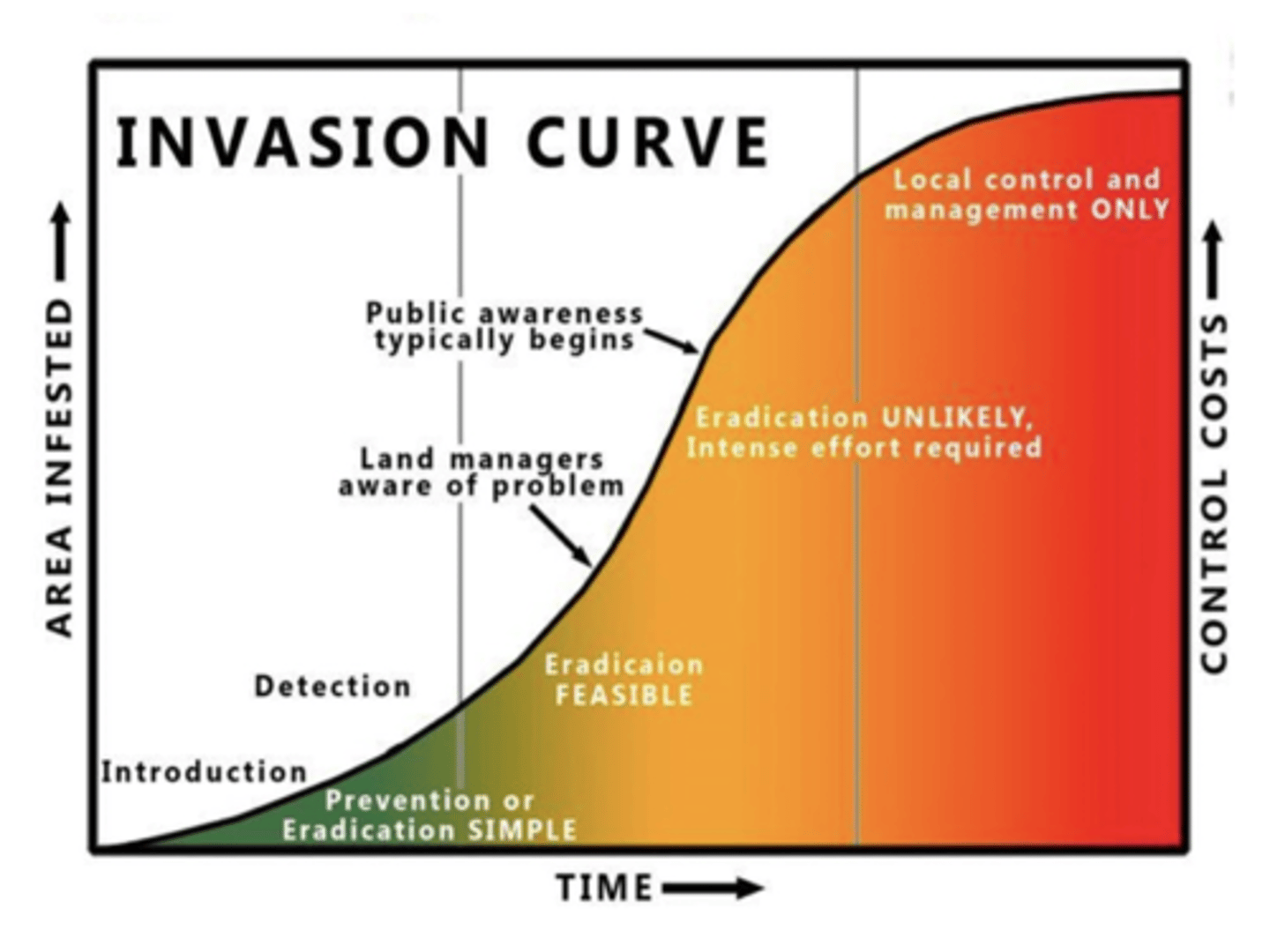Population ecology
1/42
There's no tags or description
Looks like no tags are added yet.
Name | Mastery | Learn | Test | Matching | Spaced |
|---|
No study sessions yet.
43 Terms
λ
N_t+1/N_t, 1+b-d
Finite per capita rate of population growth for discrete-time population growth model
finite rate of population change over a given time interval (often a year)
discrete-time population growth model
N_t+1 = N_t(1+b-d)
geometric population growth model
N(t) = N(0) λ^t
Cumulative finite rate of increase
100((Nt+5/Nt )-1)
If Nt + 5 = 128 and Nt is 100, then (128/100)-1 = 28%
Thus, the population has grown by 28% over 5 year
Time to reach a given population size
log(Nt) = log(N0)+t(logλ)
Stable Age Distribution
When a population is growing exponentially: the proportion of individuals in each age (or stage) class becomes stable and remains constant; each age class grows at the same exponential rate of increase
Assumptions of the Geometric Growth Model
1. Individuals in the population breed during a discrete
time period
2. Nothing changes from year to year except population abundance
3. Assumes the same birth and death rates for each
individual
4. Treats males and females the same
R0
the net reproductive rate per generation
Where species are annual breeders that live one year
R0 = λ
Generation growth
Nt = N0R0t, where t = a number of generations
What's not different between R 0 and λ
Populations grow when R0 or λ > 1
Populations decline when R0 or λ <1
Populations are at equilibrium when R0 or λ =1
Geometric Growth Model use
Appropriate when a population breeds during discrete times, where R0 = λ (annual breeders)
Exponential growth model
The rate of population increases under ideal conditions
exponential growth model equation
dN/dt = rN
○ dN/dt is the population growth rate (continuous breeders)
○ N is the population size
○ r is the instantaneous per capita rate of population growth
Exponential growth Nt equation
Nt = N0e^rt
r>0
population is growing exponentially
r<0
population is declining
r=0
population stable
R0 & r
R 0 & r are similar; give similarly shaped growth curves
○ R 0 reflects a generational growth rate
○ r denotes an instantaneous rate
○ Rough approximation: r ≈ ln R0 /T
Invasive species exponential growth example
Introduction of rabbits in Australia
○ 1859 a European introduced 12 pairs
○ In 1865, 20,000 rabbits were killed on the ranch
○ By 1900, several hundred million rabbits over most of the continent
Invasive Species and Exponential Growth

Logistic growth model
Limiting factors are environmental factors that restrict
population growth
Introduces a parameter, K
K
maximum population size a particular environment can sustain
Logistic growth model formula
dN/dt = rN (1 - N/K)
Logistic model assumptions
Assumes conditions are uniform and K is constant
Assumes that populations adjust instantaneously to
growth and smoothly approach K
time lag
results from differences in the availability of resources and the time of reproduction
increase the population growth rate over the ordinary logistic - can overshoot k
The length of the time lag might vary from 0 to 3 time
periods in extreme conditions - cycles can be seen for discrete breeders
time lag equation
If there is a time lag of length τ between the change in
population size and its effect on population growth rate,
then the population growth at time t is controlled by its
size at some time in the past, t- τ
dN/dt = rN (1 - N(t-τ)/K)
Density-Dependent Factors
mortality increases as density increases
Density-Dependent Factors example
Where patches of flower heads contain a greater number of fly larvae host plants, a greater proportion were parastized by wasps
Mortality equation
Mortality is sometimes expressed in terms of killing
power:
Killing power = log N (t) - log N(t+1)
Where N(t) is the population size before it is subject to
the mortality factor and N (t+1) is the population size
afterward
killing power example
For oak winter moth pupae on the forest floor, the killing
power of pupal predators acted in a density-dependent manner over time
Examples of density-dependent regulation factors
mortality from limited space/overcrowding
mortality from limited food
predators
parasites and diseases
Density-Independent Factors
mortality is not affected by density
extreme weather events
inverse density-dependent factors
mortality decreases as density increases
In the real world, a small population is extremely vulnerable to extinction
Below a certain critical threshold, instead of increasing, the population can spiral into a steep decline
- Stochastic and deterministic causes; abiotic and biotic
Allee effects
Decline in either reproduction or survival under conditions of low population density
Population Viability Analysis
A method of predicting whether or not a population will persist.
can find chance of going extinct
can find what population size will be less likely to go extinct
Viability of a population
○ Risk of extinction
○ Chance of recovery
○ Expected time of extinction
Viability predicted based on
Demographic data (censuses, m-r, surveys, observations of life history and p/a data)
Assessment of extinction probabilities that includes
○ Life tables
○ Population rates of increase
○ Intraspecific competition
○ Density dependence
○ K
○ Metapopulation structure
Minimum viable population
One that will give at least 95% p(persistence) for 100 years despite the foreseeable effects of demographic,
environmental, and genetic stochasticity and natural
catastrophes
Population Viability Analysis examples
bay checkerspot butterfly, african elephant
Allee effects
Logistic growth model